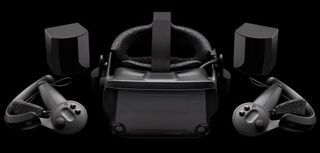Quest 2's new feature aims to make wireless VR less vomit-inducing
Air Link Framerate Insurance reduces judder from Wi-Fi issues by faking dropped frames.

Air Link Framerate Insurance is a new feature for the Meta Quest 2 headset that addresses issues some users may experience when the headset’s Air Link doesn’t play nice with their at-home wireless network.
Air Link is a feature of the Quest and Quest 2 that went live last year, which enables your headset to connect to your Wi-Fi network, letting you play PC VR games wirelessly.
As the Oculus dev blog notes (thanks UploadVR), the problem with the headset connecting to your PC via Wi-Fi instead of a dedicated transmitter is that the performance often is beholden to the Wi-Fi signal strength. So, if there is any interference, you’ll experience juddering or dropped frames which are not ideal when playing video games in VR. In fact, these sorts of drops can have rather disastrous consequences for users that are already prone to getting sick in VR.
Air Link Frame Insurance (AFI) is an experimental feature for the Quest 2 to mitigate network interference by generating a synthetic frame whenever a frame is dropped from network issues. It does it by looking at the motion between previous frames and essentially does a rough guesstimate on what it’s supposed to look like so your gameplay remains as smooth as possible.
AFI is disabled by default, so you’ll have to start the Oculus Debug Tool (ODT) and set the “Mobile ASW” drop-down to “Enabled - Framerate Insurance.
PC ASW (Asynchronous Spacewarp) is a similar feature that synthetically generates every other frame to reduce the workload on your PC.

Best VR headset: which kit should you choose?
Best graphics card: you need serious GPU power for VR
Best gaming laptop: don't get tied to your desktop in VR
Meta recommends leaving on PC ASW when you enable AFI in order to ensure maximum latency mitigation. If you’re concerned about resource consumption, disable PC ASW whenever AFI is enabled. Meta also notes that AFI doesn’t yet support 120Hz, so make sure you have your headset set to 90Hz or you’ll be hit with "significant judder and latency artifacts."
While AFI isn’t a cure-all for lousy Wi-Fi, it’s meant for the occasional signal hitch. If the signal is consistently poor, AFI won’t have enough actual frames to analyze and generate fake ones properly. So if your router is a bit older and on its last legs, consider picking a new gaming router for the cleanest Wi-Fi signal.
The biggest gaming news, reviews and hardware deals
Keep up to date with the most important stories and the best deals, as picked by the PC Gamer team.

Jorge is a hardware writer from the enchanted lands of New Jersey. When he's not filling the office with the smell of Pop-Tarts, he's reviewing all sorts of gaming hardware, from laptops with the latest mobile GPUs to gaming chairs with built-in back massagers. He's been covering games and tech for over ten years and has written for Dualshockers, WCCFtech, Tom's Guide, and a bunch of other places on the world wide web.
Most Popular





